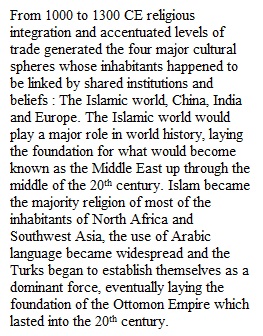


Q From 1000 to 1300 CE, a range of social and political developments contributed to the consolidation of four cultural spheres that still exist today: Europe, the Islamic world, India, and China. In what ways did these spheres interact with one another? In what ways was each sphere genuinely distinct from the others? Give examples of at least three innovations/developments that increased the scope of sea trade across Afro-Eurasia by the tenth century. What were some of the social impacts of this increased exchange?
Q From 1000 to 1300 CE, a range of social and political developments contributed to the consolidation of four cultural spheres that still exist today: Europe, the Islamic world, India, and China. In what ways did these spheres interact with one another? In what ways was each sphere genuinely distinct from the others? Give examples of at least three innovations/developments that increased the scope of sea trade across Afro-Eurasia by the tenth century. What were some of the social impacts of this increased exchange? o What was the impact of the spread of Islam to the Empire of Mali, and how did the Malian empire begin to achieve a greater international renown than any previous empire in Subsaharan Africa?Utilizing the text and video on Islam's Golden Age, briefly describe Sufism and its spread across the Islamic world. What was its significance to the Muslim world? How did Muslims show tolerance of other religions?As Islam spread into India, what impact did it have on the subcontinent, and how do we see a cultural mixing as different groups coexisted in the same space? Can you see a legacy of that in India today?
View Related Questions